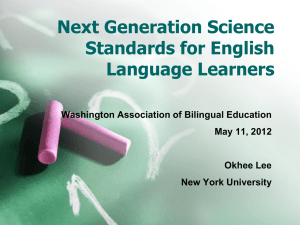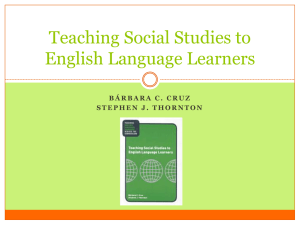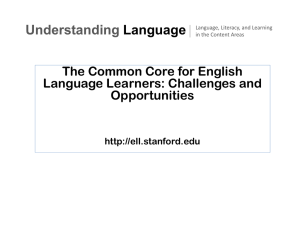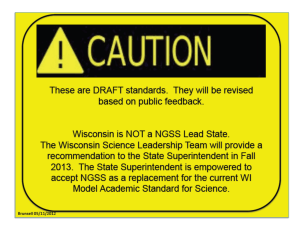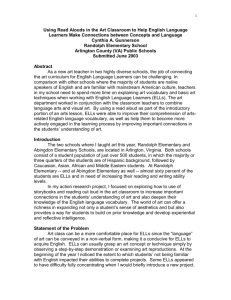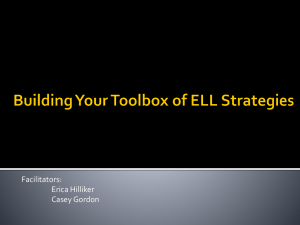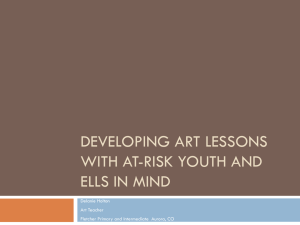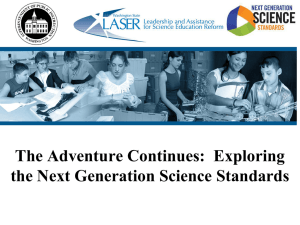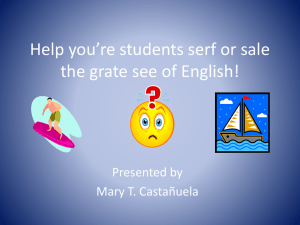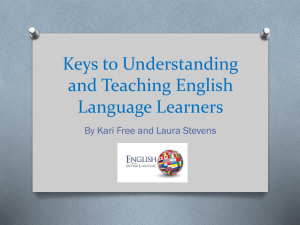UL Webinar Science Framework
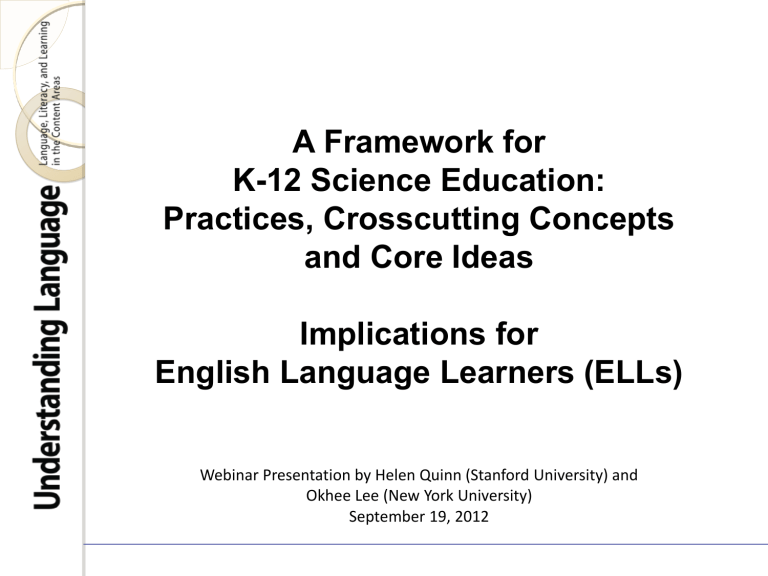
A Framework for
K-12 Science Education:
Practices, Crosscutting Concepts and Core Ideas
Implications for
English Language Learners (ELLs)
Webinar Presentation by Helen Quinn (Stanford University) and
Okhee Lee (New York University)
September 19, 2012
Basic Webinar Logistics
1.
2.
3.
4.
5.
Tina Cheuk will be facilitating this webinar.
Participants will be on MUTE (via computer and/or by phone).
Type in your questions or comments in the CHAT box in the bottom right hand corner (addressed to Tina
Cheuk or to the whole group).
Webinar is recorded and archived on our website: ell.stanford.edu
Presentation slides and recording will be available on our website by tomorrow morning.
2
Context
Education in US is controlled at the state and local level.
Common Core Math and Language Arts – 45 states, 3 territories, including D.C. choosing common standards 1
Next Generation Science Standards (NGSS)
Stage 1 NRC Framework – July 2011
Stage 2 Achieve Standards – under development, first public release in May 2012
1 Source: http://www.corestandards.org/in-the-states
3
Lead State Partners
Source: http://www.nextgenscience.org/lead-state-partners
4
Framework Standards
Assessments
Curricula
Instruction
Teacher
Preparation and development
5
Three Dimensions
Scientific and engineering practices
Crosscutting concepts
Disciplinary core ideas
Download full report at www.nap.edu
6
Goals of the Framework
Coherent investigation of core ideas across multiple years of school
More seamless blending of practices with core ideas and crosscutting concepts
Multidimensional standards and assessments
ALL students learn science
7
Questions
General questions about the Framework and NGSS
Please type in your questions in the CHAT box.
8
Scientific and Engineering Practices
1. Asking questions and defining problems
2. Developing and using models
3. Planning and carrying out investigations
4. Analyzing and interpreting data
5. Using mathematics and computational thinking
6. Developing explanations and designing solutions
7. Engaging in argument from evidence
8. Obtaining, evaluating, and communicating information
9
MATH
M1.
Make sense of problems & persevere in solving them
M6.
Attend to precision
M7.
Look for & make use of structure
SCIENCE
S5.
S2. Develop and use models
S1. Ask questions & define problems
Use mathematics & S3. Plan & carry out computational thinking investigations
M4. Model with mathematics
S4. Analyze & interpret data
M8.
Look for & express regularity in repeated reasoning
E2. Build strong content knowledge
E4. Comprehend as well as critique
E5. Value evidence
M2. Reason abstractly & quantitatively
M3. Construct viable argument & critique reasoning of others
S7. Engage in argument from evidence
S6. Construct explanations & design solutions
S8. Obtain, evaluate & communicate information
E6 . Use technology & digital media
M5 . Use appropriate tools strategically
ELA
E1. Demonstrate independence
E3. Respond to the varying demands of audience, talk, purpose, & discipline
E7. Come to understand other perspectives & cultures
Source: Working Draft, 12-6-11 by
Tina Cheuk, ell.stanford.edu
How Language Develops
Multiple opportunities to hear and use (language)
Rich contexts – desire and opportunity to engage and contribute
Appropriate supports
Acceptance of “flawed” language
11
How Science Understanding Develops
Multiple opportunities to hear and use (science ideas)
Rich contexts – desire and opportunity to engage and contribute
Appropriate supports
Acceptance of “flawed” language; for example nonscientific language
12
Promoting Both Science and Language
Learning for ELLs
ELLs can participate in classroom discourse focused on rich and exciting academic content
ELLs learn language best when they engage with academic content
Focusing on both text and discourse gives ELLs opportunities for extended engagement with complex ideas
13
Example: Argument from Evidence
Language tasks
Listen or read to understand arguments
Speak or write to express own arguments
Analyze arguments
Science tasks
Analyze, support, and refute claims of others
Present and support own claims
14
Questions
General questions about the theory of learning
Please type in your questions in the CHAT box.
15
Teacher Role
Set culture of respectful argumentation
Ensure all voices can contribute
Elicit contributions or expansion of contributions
Accept and support incomplete thoughts and “ flawed ” language (help student to clarify)
Ensure that students are understanding contributions of others (rephrase, question)
Support student questioning of others
(whether for clarification or argumentation)
16
Teacher Role
Clarify rather than correct (language or concept)
Provide language support as needed (offer or elicit from other students a needed word, or the rephrasing of a poorly expressed idea)
Reward engagement (sense-making effort)
Value logic of argument, not correctness of claim or language
Trust and support both language and science learning by the group process
17
Literacy Strategies for All Students
Incorporate reading and writing strategies
Activate prior knowledge
Promote comprehension of expository science texts
Promote scientific genres of writing
Connect science process skills (e.g., describe, explain, predict, conclude, report) to language functions (e.g., explain, compare, contrast)
Encourage use of graphic organizers (e.g., concept map, word wall, Venn diagram, KWL)
18
ESOL Strategies for ELLs
Use language support strategies
Use realia (real objects or events)
Encourage multiple modes of representations (gestural, oral, pictorial, graphic, textual)
Use graphic devices (graphs, charts, tables, drawings, pictures)
Use a small number of key terms in multiple contexts
19
Home Language Support
Present science terms in multiple languages in the beginning of each lesson
Use cognates (and highlight false cognates) in home language
Allow code-switching
Encourage ELLs to use home language to read, discuss or write about science
Encourage bilingual students to assist less English proficient students in their home language (group, not one to one)
20
Home Culture Connections
Build on students ’ lived experiences at home and in the community (i.e., funds of knowledge)
Explore culturally-based ways students communicate and interact in their home and community (i.e., cultural congruence)
Use students ’ cultural artifacts, culturally relevant examples, and community resources
21
Questions
Teacher role to support science and language learning
Please type in your questions in the CHAT box.
22
Resources
1.
Language Demands and Opportunities in Relation to the Next Generation
Science Standards, by Helen Quinn, Okhee Lee, and Guadalupe Valdés.
http://ell.stanford.edu/publication/3-language-demands-and-opportunitiesrelation-next-generation-science-standards-ells
2.
A Framework for K-12 Science Education: Practices, Crosscutting Concepts, and Core Ideas. http://www.nap.edu/catalog.php?record_id=13165
3.
Diversity and Equity in the NGSS: All Standards, All Students http://www.nextgenscience.org/next-generation-science-standards
4.
NSTA series of free webinars focused on the 8 practices. (9/11-12/18).
http://learningcenter.nsta.org/products/symposia_seminars/Ngss/websemin ar.aspx
23
Thank you!
Thank you to everyone who participated today.
We will post the presentation and recording on our website in the morning.
Please give us feedback on this presentation and any other information that would be helpful to our team in supporting your work.
For more information, contact
UnderstandingLanguage@stanford.edu
(Tina Cheuk)
24

